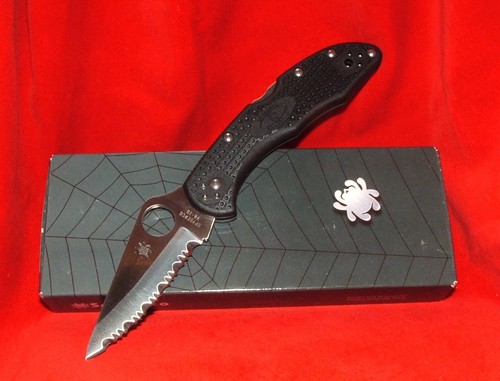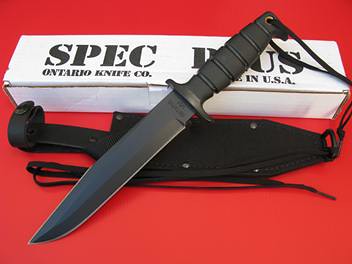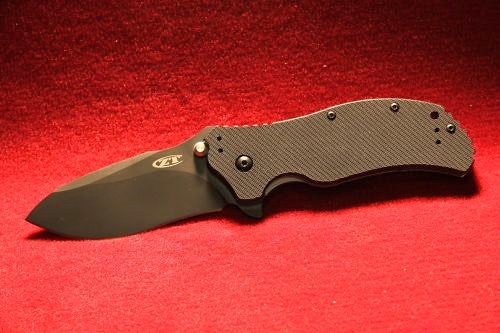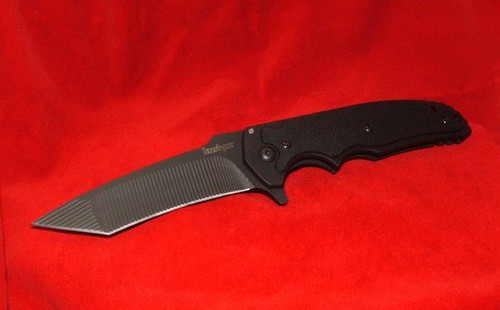We have a similar situation with the handgun crowd. Will there ever be an end to the single-action/double-action/striker-fired ad-nauseum arguments about which is "best" for a particular job? One can only hope, but I'm not holding my breath. Lest we lose our collective sanity over these and other equally actually rather mundane issues, let's figure out exactly what a "tactical" knife is and try to inject a bit of sense into it all.
A good friend of mine used to carry a biggish folding Stockman knife, with old fashioned jigged bone handles and blades worn skinny from sharpening. He could cut an apple with it, skin a squirrel and even cut a seatbelt if he needed to. He carried it in WWII, and I'm sure put it to no end of important and semi-important tasks then, in what was surely a "tactical" situation if ever there was one. The really funny thing is nobody called 'em "tactical" knives then.
But today, I'll bet I could cut an apple, skin a squirrel and even cut a seatbelt with a modern "tactical" knife if I needed to. So maybe there's a lesson there and the lesson is not so much what a knife can do, but how it looks. A classic Case gentleman's folder does not look tactical. A MOD-anything definitely looks tactical. Is there some cross-over in capability? You bet. Are some of the bigger, nastier looking "tacticals" tough-enough to beat through a car door? Absolutely. So maybe it isn't exactly how it looks so much as what it can do that's important. A simple diving knife "pry-bar" blade is pretty "tactical" if you ask me and could really perform in the role on land--but I confess I've never heard of a "tactical" abalone knife. Thank God.
So let's call them what they are--High Performance Knives. And, let's not care what they "look" like. While looks can be cool (nothing wrong with that), don't be deceived into thinking simply because a knife "looks" tactical--it is tactical. My friend's Stockman was a pretty high-performance knife for its time but definitely did not look tactical. Some of today's pretty cool-looking "tactical" folders are just that: cool looking, and lack any real world ability to perform. As a matter of fact, many of them, in a mis-guided attempt to be "cool" cross the boundary and become "stupid"--which is another term to gel familiar with when you talk about "tactical" knives. Let's break this simple "Performance" category into three parts.
There are clearly genuine "High Performance" knives. Frankly, if you look at any knife in any of the photos here, you'll see one. They are all top quality, solid designs and none of them would ever let you down within the parameters of their capabilities. But there's a "Medium Perfomance" zone, a sort of "really affordable" knife that delivers well-enough to handle most jobs you'd encounter. After all, as Clint Smith might say, we're not all really Ninjas.
But then there's the all-important "No Performance" category. We won't name any names, but if it "looks" like a big-name high performance knife that usually costs big bucks and it's for sale on that swap-meet table for "Only $4.95," I'll bet we can guess which category it fits into. With high-performance knives, if it sounds too good to be true, then it's, er, ah, too good to be true. Every time.
What Really Counts?
High-Performance means exactly what it says: The ability to handle the task--from the mundane to the critical--reliably and with a kind of fluidity of function the job almost becomes effortless. Those are big things to live up to. What do you need to keep in mind when you choose your own idea of this mythical molecule separator?
The big thing most people get caught-up with is blade material. The reality with modern, high quality knives, is virtually any of the blade steel will out-last you. Keep in mind, the harder the steel, the more difficult it is to sharpen and an easy sharpening knife is a wonder to behold. It's also almost impossible to find a high-performance knife these days that doesn't have a stainless steel blade, so even the whole rusting thing is pretty much a moot point. Especially with the exotic "diamond/carbon/boron/Kool-Aid" coatings commonly encountered on blades these days. Plus the colors are sorta' pretty too.
Blade Shape
This one can really start fights. Just remember, a bit smaller than you think is probably better and the shape can almost always be simply whatever you like personally. Like a drop-point? Buy it. Does a spear-point get your blood going? Go for it. In reality, and much to the chagrin of some knife-makers, just about any blade can get the "job" done, so enjoy yourself; but just keep that "quality" thing in mind when you buy. And don't forget those nifty thumb-studs and blade cut outs that allow one handed opening. That's one of the things (thank you Spyderco) that started the whole industry and made this kind of knife so appealing.
Blade Locks
The "locking method du-jour" is another thing making potential buyers crazy. Once again, from the simple and elegant liner-lock, to the more exotic levers, widgets, cams and rollers out there, none of the high-quality factory makers produce anything that could be considered unsafe. Are some potentially "stronger" than others? Probably, but in the real world, I doubt you'd ever be able to break one unless you asked it to do something it was never designed for in the first place.
Scales
Handle material is constantly changing. In the early days, linen Micarta was the top pick, but today everything from exotics plastics like G-10 (whatever that is ...) to polymers, metals and even natural materials like bone, wood and ivory are showing up on these high-performance knives. Pick the one you like. If the knife is going to live really hard (salt water, bashing around, little or no maintenance and such) go for one of the metal/plastic/man-made materials.
Pocket Clips
The "wonder of wonders" that, if anything, is the immediate identifier of the genre, is the pocket clip. The introduction of the clip single-handedly changed the way people carry pocket knives forever. No more digging for old-reliable buried in those tight jeans, and the world is a better place for it. Today's folders often have the ability to allow the user to change both the side and the position of the clip. This allows for lefties and whoever to customize the carry-mode, to meet their own needs. "Point-down" and "point-up" carry can become very personal issues and this feature makes it happen just the way you want it to. Watch for it if it's important for you.
Pry Tool?
If anything, the modern high-performance knife has often morphed into an "emergency, sharp, pry-tool" and we're better off for it. In my 20-odd years as a street cop, I have to admit I used my knife to do much more prying than cutting. From lifting windows out of tracks, prying battery clamps off terminals at accident scenes, scraping registration tabs off of license plates, digging for evidence and generally poking and prodding about, the idea of a "short-sharpened pry-tool" has always made sense. If you're looking for really heavy-duty work, I'd opt for short, stocky blades, better able to take the abuse that prying subjects a blade to.
Knife Fighting?
This is a tender topic. While it's certainly possible you may have to defend yourself with your knife, let's hope you don't have to. It's almost always messy, everyone usually gets cut and/or stabbed and there are much more efficient ways to manage the situation. Like any police officer would say, "We usually bring guns to those kinds of fights." There's a lesson there somewhere.
Guns and Knives
And one more thing, chances are pretty good if you carry a handgun either in the field or as personal protection, you probably have a high or at least "medium" performance knife clipped to your britches. If not, it's time to seriously re-evaluate your equipment check-list. The two go together like a 2" .38 and a Benchmade.
COPYRIGHT 2005 Publishers' Development Corporation
COPYRIGHT 2005 Gale Group
All Comments are Welcome and Appreciated.













No comments:
Post a Comment